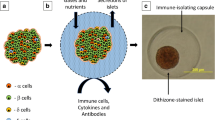Abstract
The success of diabetes treatment with bioartificial pancreas is still hindered by a high rate of graft failure caused by poorly functioning cells. The incretin effect of glucagon like peptide-1 (GLP-1) make this peptide an attractive therapeutic agent to improve the success of transplantation of encapsulated beta cells. Our objective was to develop a novel model based on the co-encapsulation of beta cells with nanoparticles containing GLP-1 on alginate hydrogels, allowing its delivery and action in the specific target, beta cells. To this end, poly(lactide-co-glycolide) (PLGA) nanoparticles containing GLP-1 were prepared to be encapsulated together with INS-1E beta cells. Then, cells were encapsulated in alginate alone (Alg 0) and co-encapsulated with PLGA nanoparticles containing GLP-1 (Alg GLP-1). Hydrogels were maintained in culture during 7 days for evaluation of GLP-1’s influence in cellular performance, namely the crucial feature of insulin secretion. PLGA nanoparticles had an average size of 169.3 nm, a polydispersity index of 0.05 and an average zeta-potential of −24.3 mV. The average association efficiency of GLP-1 was 65.4% and the in vitro release test showed 71% of GLP-1 delivery after 7 days. Comparing the cellular conditions (Alg 0 and Alg GLP-1), the presence of nanoparticles led to increased cellular metabolic activity and 8-fold higher insulin levels. Our results reveal a promising successful role of GLP-1 nanoparticles in ensuring the viability of encapsulated beta cells in alginate hydrogel, by promoting its proper delivery and action. Further studies are needed to extensively characterize this new model of bioartifical pancreas.




Similar content being viewed by others
References
Crisóstomo J, Coelho J, Seiça R. Bioartificial Pancreas: In the Road to Clinical Application. In: Coelho J, editor. Drug Deliv. Syst. Adv. Technol. Potencially Apl. Pers. Treat. Springer; 2013. p. 127–51.
Sun J, Tan H. Alginate-Based Biomaterials for Regenerative Medicine Applications. Materials (Basel). 2013;6:1285–309.
Wilson JT, Chaikof EL. Challenges and emerging technologies in the immunoisolation of cells and tissues. Adv Drug Deliv Rev. 2008;60:124–45.
Brubaker P, Drucker D. Minireview: glucagon-like peptides regulate cell proliferation and apoptosis in the pancreas, gut, and central nervous system. Endocrinology. 2004;145:2653–9.
Puddu A, Sanguineti R, Mach F, Dallegri F, Viviani GL, Montecucco F. Update on the protective molecular pathways improving pancreatic beta-cell dysfunction. Mediat Inflamm. 2013;2013:1–14.
Holst JJ. The physiology of glucagon-like peptide 1. Physiol Rev. 2007;87:1409–39.
Toyoda K, Okitsu T, Yamane S, Uonaga T, Liu X, Harada N, et al. GLP-1 receptor signaling protects pancreatic beta cells in intraportal islet transplant by inhibiting apoptosis. Biochem Biophys Res Commun. 2008;367:793–8.
Bohman S, Waern I, Andersson A, King A. Transient beneficial effects of exendin-4 treatent on the function of microencapsulated mouse pancreatic islets. Cell Transplant. 2007;16:15–22.
Kim S, Wan Kim S, Bae YH. Synthesis, bioactivity and specificity of glucagon-like peptide-1 (7-37)/polymer conjugate to isolated rat islets. Biomaterials. 2005;26:3597–606.
Lin CC, Anseth KS. Glucagon-like peptide-1 functionalized PEG hydrogels promote survival and function of encapsulated pancreatic beta-cells. Biomacromolecules. 2009;10:2460–7.
Chepurny OG, Holz GG. Over-expression of the glucagon-like peptide-1 receptor on INS-1 cells confers autocrine stimulation of insulin gene promoter activity: a strategy for production of pancreatic beta-cell lines for use in transplantation. Cell Tissue Res. 2002;307:191–201.
Kim S, Bae Y. Long-term insulinotropic activity of glucagon-like peptide-1/polymer conjugate on islet microcapsules. Tissue Eng. 2004;10:1607–16.
Sadat TM, Nejati-Koshki K, Akbarzadeh A, Yamchi MR, Milani M, Zarghami N, et al. PLGA-based nanoparticles as cancer drug delivery systems. Asian Pacific J Cancer Prev. 2014;15:517–35.
Araújo F, Shrestha N, Shahbazi M-A, Fonte P, Mäkilä EM, Salonen JJ, et al. The impact of nanoparticles on the mucosal translocation and transport of GLP-1 across the intestinal epithelium. Biomaterials. 2014;35:9199–207.
Bidarra S, Barrias C, Barbosa M, Soares R, Granja P. Immobilization of human mesenchymal stem cells within RGD-grafted alginate microspheres and assessment of their angiogenic potential. Biomacromolecules. 2010;11:1956–64.
Crisóstomo J, Pereira AM, Bidarra SJ, Gonçalves AC, Granja PL, Coelho JF, et al. ECM-enriched alginate hydrogels for bioartificial pancreas: an ideal niche to improve insulin secretion and diabetic glucose profile. J. Appl. Biomater. Funct. Mater. NLM (Medline). 2019, 17:1–13.
de Vos P, Faas MM, Strand B, Calafiore R. Alginate-based microcapsules for immunoisolation of pancreatic islets. Biomaterials. 2006;27:5603–17.
Qi M. Transplantation of encapsulated pancreatic islets as a treatment for patients with type 1 diabetes mellitus. Adv Med 2014;2014.
Luo G, Kong X, Lu L, Xu X, Wang H, Ma X. Glucagon-like peptide 1 potentiates glucotoxicity-diminished insulin secretion via stimulation of cAMP-PKA signaling in INS-1E cells and mouse islets. Int J Biochem Cell Biol. 2013;45:483–90.
Acknowledgments
The present work is a collaboration between iCBR and INEB/i3S, supported by the Portuguese Foundation for Science and Technology: FCT Strategic Plan UID/NEU/04539/2013, UID/BIM/04293/2013 and SFRH/BD/72964/2010.
Author information
Authors and Affiliations
Corresponding author
Ethics declarations
Conflict of interest
All authors comply to Springer’s ethical policies. The authors report no conflicts of interest in present work. This article does not contain any studies with human participants or animals performed by any of the authors.
Additional information
Publisher’s note
Springer Nature remains neutral with regard to jurisdictional claims in published maps and institutional affiliations.
Rights and permissions
About this article
Cite this article
Crisóstomo, J., Araújo, F., Granja, P. et al. Increasing levels of insulin secretion in bioartificial pancreas technology: co-encapsulation of beta cells and nanoparticles containing GLP-1 in alginate hydrogels. Health Technol. 10, 885–890 (2020). https://doi.org/10.1007/s12553-020-00427-4
Received:
Accepted:
Published:
Issue Date:
DOI: https://doi.org/10.1007/s12553-020-00427-4




